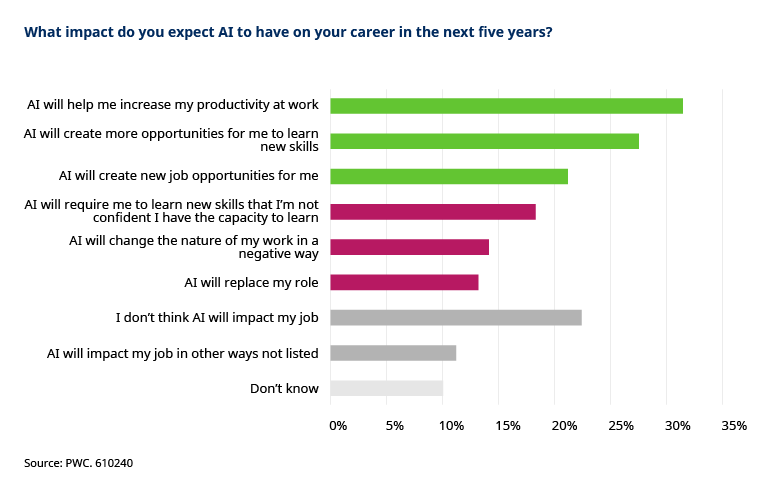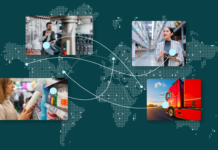We look at the implications of artificial intelligence (AI) for workers and some of its potential uses within human resources.
There are over one billion knowledge workers in the global economy today. Work done in these industries contributes about 50% of GDP in major economies. The infusion of knowledge work with AI has transformative potential, but it has sparked significant debate about the threat to jobs and the nature of work.
Here we look at what AI might mean for jobs, taking into account historical examples of automation. We also look at how companies might use AI as a differentiator in getting the best out of their employees.
AI is still an emerging technology and use cases for it are evolving, so we would caution against drawing firm conclusions at this stage.
Will AI destroy jobs?
One of the biggest worries around the adoption of AI, particularly generative AI like ChatGPT, is that it may render human workers redundant. That said, we have been automating work for 200 years. Every time we go through a wave of automation, whole classes of tasks go away but new classes of tasks – and new jobs – are created.
There is friction, pain, and disruption in that process, and sometimes the new jobs go to different people in different places. But over time, the total number of jobs has not gone down, and society, generally, has been better off for it.
For example, research suggests that only one of the 271 detailed occupations listed in the 1950 US Census has since been entirely eliminated because of full automation: that of the elevator operator (Bessen, 2016). Looking further back through time, the job of a carriage maker had by 1950 already been largely substituted by jobs for automobile-body makers, due to the change in technology, but certain tasks embedded in the incumbent occupation were transferred from old to new.
Folding pre-existing tasks into net new tasks, thereby substituting one job for another, has been a common consequence of automation and technology evolution. It is important to distinguish between the dissolution of jobs through the automation of all the associated tasks, and the substitution of certain tasks into new types of jobs.
Complexity of integrating AI into knowledge work
Up to now, automation has largely affected manufacturing roles. In the early 20th century, scientific management broke down jobs or roles into pieces so that you could identify singular tasks that could then be augmented with automation. This set the path for the introduction of machinery into manufacturing lines, building the stage for shift work and factories running 24/7. Does AI imply the same for knowledge industries?
A typical knowledge worker’s day will comprise a wide variety of tasks being assimilated and performed. Automating much of this will be complicated, not least because every company has multiple technology systems.
However, there may well be scope for the automation of some tasks, improving speed and/or accuracy and leaving the worker free to focus on the human-centric elements of their job.
Potential for AI to enhance productivity
There have been a few academic studies that have begun to look specifically at ChatGPT in desk-based work. A study by Noy and Zhang (2023) of writing tasks by mid-level university educated professionals found 40% time savings in some circumstances with quality improving (specifically at the lower end of the spectrum).
Back in 2013, Harvard Business Review published numbers suggesting knowledge workers spent three hours per day on desk-based tasks, with the rest being applied to collaboration, meetings, and so on. Apply a 40% time saving to this, and you might conceivably see knowledge workers, powered by generative AI, delivering five days’ worth of work in just three, with all that entails for augmented output, and possible changes in work-life balance.
As our appreciation of the potential use cases for generative AI evolves, we expect the narrative to shift from being one focused on the disruptive or threatening consequences, to one focused on the upside.
This is not just about productivity; it also relates to skills gaps. There are estimates that suggest the world will be short of as many as 85 million jobs, costing as much as US$8.5 trillion in GDP. AI may at the very least help companies, and countries, facing demographic or skills-related labour shortages.
How can companies use AI to optimise their workforce?
We think AI can have multiple beneficial uses in the field of human capital management, which is the way in which an organisation seeks to maximise the value of its human capital. Methods include talent development, workforce planning, investment in culture, and so on.
There is an argument that as manufacturing facilities and equipment become more standardised over time, human capital management becomes an increasingly important differentiator in returns. Prior to the introduction of large language models (LLMs) and GPT, the core productive ‘assets’ in knowledge industries were people. But as AI is integrated into the services sectors, this introduces digital assets – the underlying models – whose foundations are common across users.
Therefore, the degree to which two companies using GPT can extract different results lies in their ability to incorporate proprietary data, to integrate it into tasks more efficiently, and to use the technology better (e.g., via more effective prompts). The second and third of these are human capital management topics.
Opportunity for AI in upskilling
Perhaps the most obvious opportunity for incorporating AI and LLMs in human capital management exists in talent and learning systems. This is partially a function of the growing skills gaps that organisations face across numerous industries today. It is also due to the malleability of people as an asset that can transform, evolve, and ultimately become more valuable.
In a recent survey of full-time US office workers, Jefferies research found that 82% of people would be motivated to improve their skill sets if they feared automation could replace their current role.
While we continue to advocate for firms to monitor and consider the effectiveness of dollars and time spent on training, the opportunity to use training to repurpose workers where tasks can be fulfilled by AI – and to use AI to augment training experiences – is tantalising.
As evidenced in PwC’s Global Workforce Hopes and Fears Survey 2023, just over half of workers are excited about the benefits AI can bring to them, largely via new skills and opportunities, while only a third are more negatively inclined.

AI uses in workforce strategy and analytics
The pressure on organisations to be more agile and do more with fewer resources has been profound in recent years. Strategic workforce planning is central to this with its focus on capability, competitiveness, and delivery.
Applying LLMs in this arena could elevate the dexterity of HR departments, support talent functions with skills development, and increase the sustainability (and thus value) of a company’s human capital through time.
In terms of analytics, every head of HR wants better data about their workforce. This could be part of employee listening – reading and summarising reviews and freeform answers to surveys to identify the mood of the workforce or burnout. Or it could relate to models used to assess high potential and performance.
What can investors ask management about AI and human capital management?
As uses of AI evolve, so will the questions we ask. However, the below captures some of the questions that seem currently most pertinent.
- What is your view of the most important benefits and risks to your business and workers from the continued development of AI?
- What steps have you taken, and what steps do you plan to take, to integrate AI capabilities within your business?
- Do you expect to allocate significant amounts of financial or human capital to AI, or to make significant changes in personnel as a result of AI?
- Are you working to use AI to better match skills and talent to opportunities, to identify skills gaps in your strategy or to improve workforce planning and your agility?
- How do you ensure that AI is not introducing biases into your processes?
- How are employees being trained to work effectively with AI tools and technologies in talent management?
- Is AI being used to support career development and internal mobility?
















